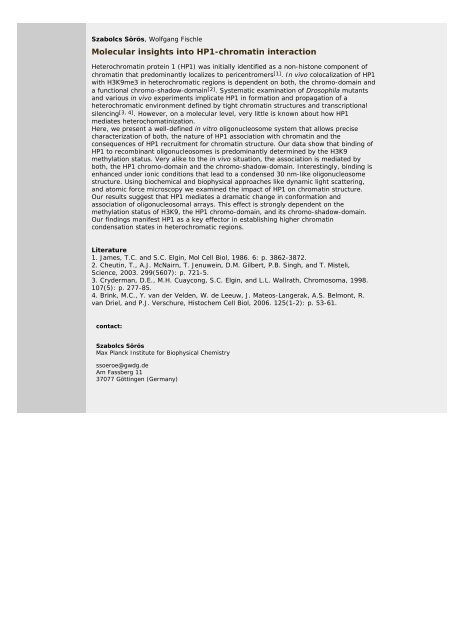Abstracts (poster) - Wissenschaft Online
Abstracts (poster) - Wissenschaft Online
Abstracts (poster) - Wissenschaft Online
Create successful ePaper yourself
Turn your PDF publications into a flip-book with our unique Google optimized e-Paper software.
Szabolcs Sörös, Wolfgang Fischle<br />
Molecular insights into HP1-chromatin interaction<br />
Heterochromatin protein 1 (HP1) was initially identified as a non-histone component of<br />
chromatin that predominantly localizes to pericentromers [1] . In vivo colocalization of HP1<br />
with H3K9me3 in heterochromatic regions is dependent on both, the chromo-domain and<br />
a functional chromo-shadow-domain [2] . Systematic examination of Drosophila mutants<br />
and various in vivo experiments implicate HP1 in formation and propagation of a<br />
heterochromatic environment defined by tight chromatin structures and transcriptional<br />
silencing [3, 4] . However, on a molecular level, very little is known about how HP1<br />
mediates heterochomatinization.<br />
Here, we present a well-defined in vitro oligonucleosome system that allows precise<br />
characterization of both, the nature of HP1 association with chromatin and the<br />
consequences of HP1 recruitment for chromatin structure. Our data show that binding of<br />
HP1 to recombinant oligonucleosomes is predominantly determined by the H3K9<br />
methylation status. Very alike to the in vivo situation, the association is mediated by<br />
both, the HP1 chromo-domain and the chromo-shadow-domain. Interestingly, binding is<br />
enhanced under ionic conditions that lead to a condensed 30 nm-like oligonucleosome<br />
structure. Using biochemical and biophysical approaches like dynamic light scattering,<br />
and atomic force microscopy we examined the impact of HP1 on chromatin structure.<br />
Our results suggest that HP1 mediates a dramatic change in conformation and<br />
association of oligonucleosomal arrays. This effect is strongly dependent on the<br />
methylation status of H3K9, the HP1 chromo-domain, and its chromo-shadow-domain.<br />
Our findings manifest HP1 as a key effector in establishing higher chromatin<br />
condensation states in heterochromatic regions.<br />
Literature<br />
1. James, T.C. and S.C. Elgin, Mol Cell Biol, 1986. 6: p. 3862-3872.<br />
2. Cheutin, T., A.J. McNairn, T. Jenuwein, D.M. Gilbert, P.B. Singh, and T. Misteli,<br />
Science, 2003. 299(5607): p. 721-5.<br />
3. Cryderman, D.E., M.H. Cuaycong, S.C. Elgin, and L.L. Wallrath, Chromosoma, 1998.<br />
107(5): p. 277-85.<br />
4. Brink, M.C., Y. van der Velden, W. de Leeuw, J. Mateos-Langerak, A.S. Belmont, R.<br />
van Driel, and P.J. Verschure, Histochem Cell Biol, 2006. 125(1-2): p. 53-61.<br />
contact:<br />
Szabolcs Sörös<br />
Max Planck Institute for Biophysical Chemistry<br />
ssoeroe@gwdg.de<br />
Am Fassberg 11<br />
37077 Göttingen (Germany)

















